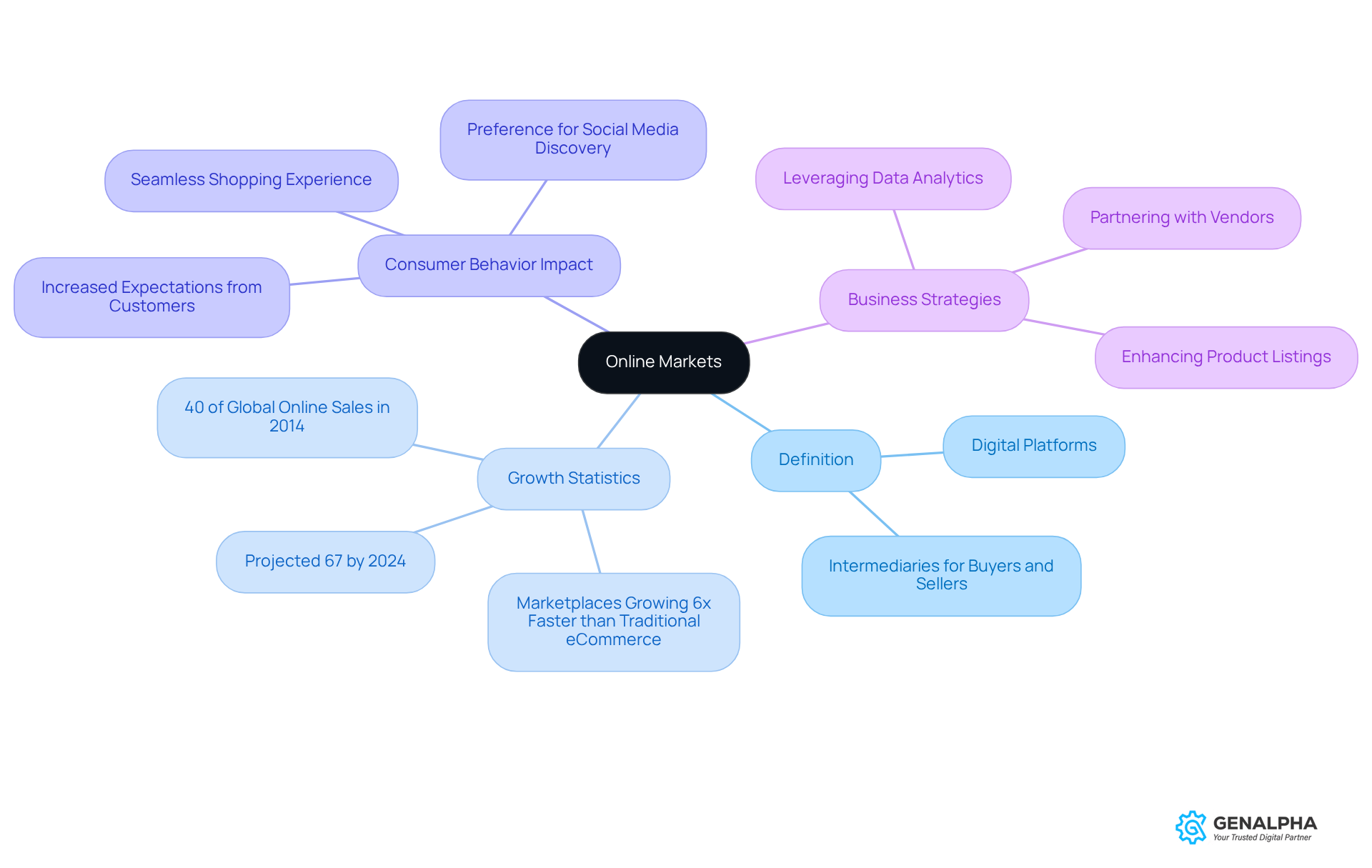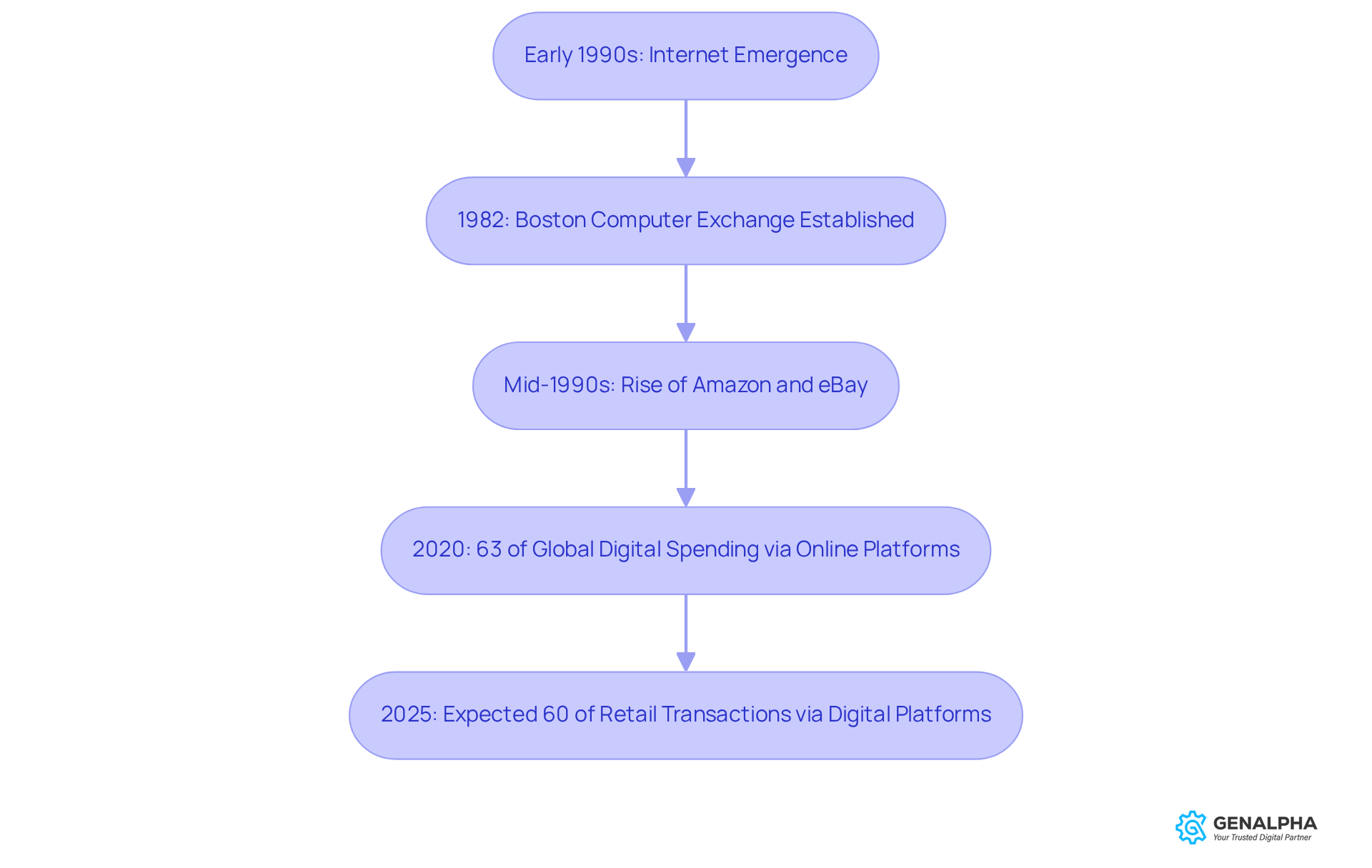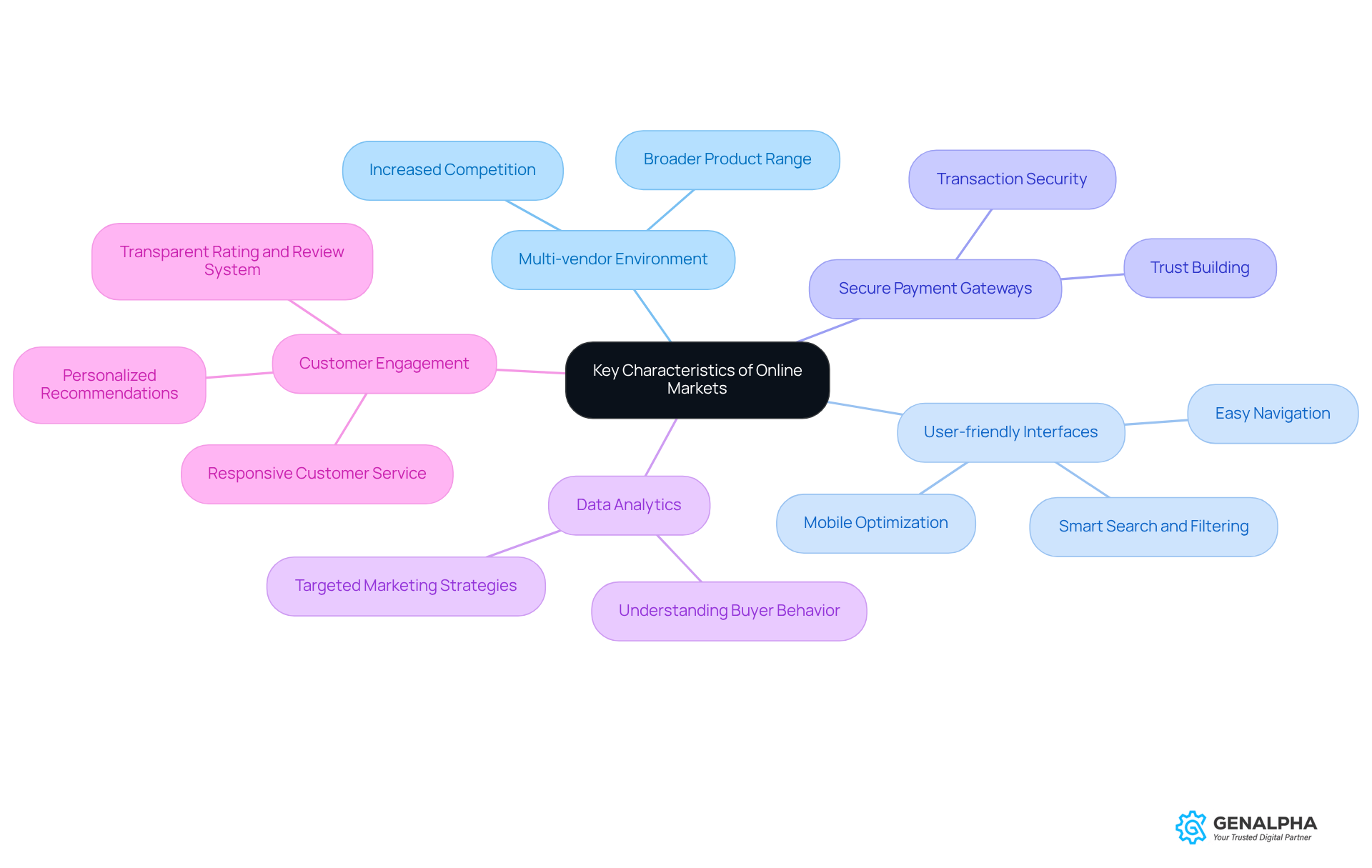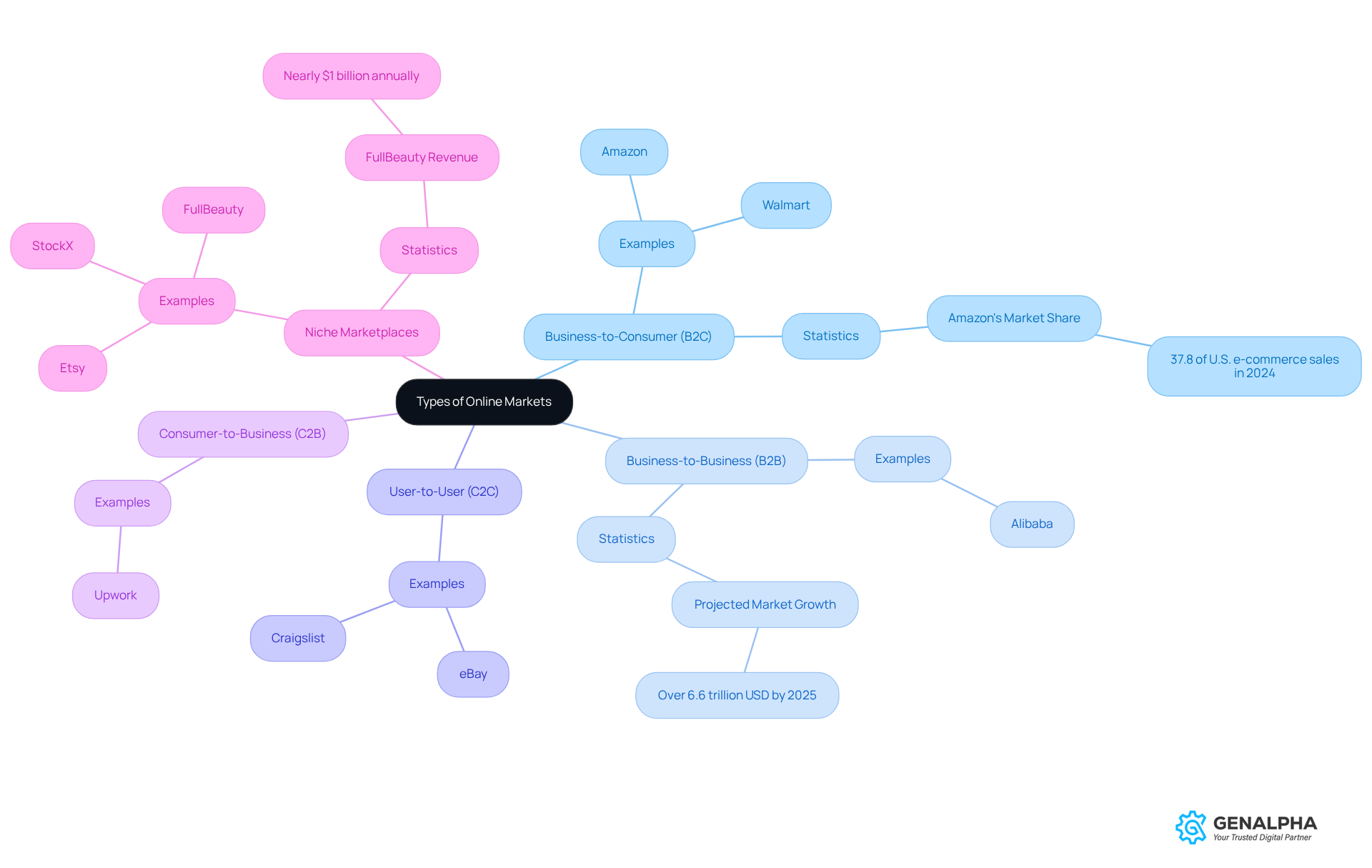Overview
Have you ever thought about how online markets, or online marketplaces, have changed the way we shop? These digital platforms connect multiple sellers with buyers, creating a centralized space that makes browsing and purchasing goods and services easier than ever. It’s pretty amazing how they’re reshaping traditional retail!
As we dive into this topic, it’s clear that the growth of these platforms is not just a trend; it’s transforming consumer behavior and business strategies alike. For example, did you know that their share of global e-commerce sales is on the rise? Businesses are feeling the pressure to adapt, and that means getting creative with marketing and enhancing user experiences.
So, what does this mean for you? It’s all about staying ahead of the curve. Whether you’re a shopper looking for the best deals or a business trying to reach new customers, understanding these changes can help you navigate the evolving landscape of online shopping. Let’s explore this exciting world together!
Introduction
Online markets have become key players in today's business world, changing how we buy and sell. These digital platforms create a space where buyers and sellers come together, giving businesses amazing access to customers around the globe. As we see more companies shift toward these marketplaces, you might wonder: how can businesses navigate this changing landscape to unlock their full potential? Understanding the ins and outs of online markets is crucial for anyone looking to succeed in a competitive digital economy. So, let's dive in and explore how you can thrive in this exciting environment!
Defining Online Markets: An Overview
What are online markets, often referred to as , which are that facilitate the buying and selling of goods and services between vendors and clients? Think of them as intermediaries, where various sellers can showcase their products, and buyers have a centralized space to browse and snag what they need. You’ve probably heard of popular platforms like Amazon, eBay, and Etsy—they cater to a wide range of consumer preferences and needs. The explosion of internet markets has truly reshaped traditional retail, giving businesses the chance to connect with a global audience, streamline transactions, and boost customer engagement through digital interfaces.
Now, let’s talk about how these [digital platforms](https://blog.genalpha.com/10-benefits-of-guided-selling-tools-for-equipment-manufacturers) have really changed the game. Back in 2014, platforms accounted for 40% of global internet sales, and that number is projected to jump to 67% by 2024. Isn’t that fascinating? This shift reflects a growing trend among shoppers, with now leaning towards platforms instead of traditional eCommerce sites.
The significant impact of what are online markets on how we shop cannot be overlooked. They create a , allowing us to compare items, read reviews, and make informed decisions—all from one convenient spot. This ease of use has raised customer expectations, pushing businesses to rethink their strategies to stay competitive. For instance, brands that tap into social media for product discovery, especially targeting Gen Z and millennials, are likely to thrive in this evolving landscape.
So, what can producers and distributors do to stand out on these digital platforms? It boils down to a few key strategies:
- Enhancing product listings
- Partnering with external vendors to expand inventory
Take EZ Bombs, for example. They ramped up their presence on TikTok Shop and saw an incredible 30x return on ad spend in just 90 days, raking in over $5 million in a single quarter! Plus, with the integration between Amazon and TikTok, users can shop for Amazon products directly within the TikTok app. Talk about innovative strategies that manufacturers and distributors should consider!
In conclusion, online platforms are not just about buying and selling; they’re also . As these platforms continue to grow, adopting creative approaches will be crucial for producers and suppliers looking to seize the opportunities available in the digital landscape. As Brianna Conley pointed out, , emphasizing the need for businesses to adapt to these new models.

The Evolution of Online Markets: History and Development
, which exemplify , really kicked off in the early 1990s, thanks to the internet coming into play. Remember the Boston Computer Exchange? It started back in 1982 and was a game changer, letting folks buy and sell pre-owned computers. But it was the mid-1990s that truly shook things up with . These platforms didn’t just bring auction-style selling to the table; they opened the door to a whole range of items, changing how we shop forever.
Fast forward to today, and are the backbone of virtual commerce. Mobile commerce has made shopping a breeze, while social media platforms have stepped up product discovery and consumer engagement. By 2025, it’s expected that digital platforms will account for over 60% of total retail transactions worldwide—talk about dominating the ! And just to highlight the shift, in 2020, a whopping 63% of global digital spending happened through these platforms, marking a 29% increase from the previous year.
Experts are clear: the shift from traditional retail to what are online markets isn’t just a fleeting trend; it’s a major shift in how we buy. As these platforms keep evolving, they’re tapping into AI and data analytics to and fine-tune . For example, AI-driven traffic to U.S. retail sites is projected to surge by 520%, showing just how much technology is reshaping consumer engagement.
Look at the case studies, and you’ll see that businesses using these technologies have seen incredible boosts in and customer satisfaction. Take Jessica's mug store, for instance. After rolling out AI product options that let customers design their own mugs with a 3D preview, she saw a 42% increase in average order value. Pretty impressive, right?
The journey of online platforms has been all about innovation, with each step paving the way for the next. As we look ahead, it’s clear that will reshape the retail landscape, making them essential for both shoppers and businesses. Plus, the rise of vertical and niche marketplaces indicates a shift towards more specialized platforms that cater to specific buyer needs. What do you think the future holds for us in this ?

Key Characteristics of Online Markets: Structure and Functionality
Have you ever thought about and what makes them so appealing? One standout feature is the multi-vendor environment. What are online markets? They are platforms that allow various sellers to showcase their products all in one place, giving you, the consumer, more choices than ever. This setup not only broadens the range of products available but also raises the question of what are online markets, as it , which can lead to better prices and services. Did you know that customers who shop across multiple channels tend to spend more? That really highlights how important a is.
Now, let’s discuss what are online markets and how they feature . These elements are crucial for any successful , especially when considering what are online markets. A well-designed interface makes it easy for you to navigate and discover products, ensuring you can quickly find what you’re looking for. For example, platforms that optimize their layout and include features like smart search and filtering options are prime examples of what are online markets that often see happier, more engaged users. And with mobile devices accounting for 61% of marketplace sales, it’s clear that marketplaces need to cater to mobile users.
are another must-have for safe transactions, which helps build trust among users. A solid payment gateway gives you peace of mind that your transactions are secure. When you pair that with responsive customer service, it really helps address any questions or issues you might have, leading to greater satisfaction. Plus, a is key for building trust, allowing you to make informed choices and encouraging sellers to respond to customer feedback.
And let’s not forget about what are online markets and their importance to ! This plays a vital role in understanding what are online markets. By tapping into insights about , sellers can craft targeted marketing strategies that truly resonate with you. This data-driven approach not only boosts sales performance but also helps cultivate long-term customer loyalty.
All these features come together to create a smooth shopping experience that benefits both you and the vendors. It’s clear that digital platforms are becoming essential players in today’s . So, next time you shop online, think about all the elements working behind the scenes to make your experience seamless!

Types of Online Markets: Examples and Variations
Have you ever wondered what are and the ? They can actually be categorized based on how they operate and who they serve. Let’s dive into some of the most common types:
- Business-to-Consumer (B2C): Think about marketplaces like Amazon and Walmart. These platforms allow businesses to sell directly to you, the consumer, tapping into huge customer bases and a wide range of products. In fact, in 2024, Amazon is expected to account for about 37.8% of in the U.S. That’s a clear sign of how dominant B2C platforms are!
- : Now, let’s look at platforms like Alibaba. They’re all about , making it easier for them to buy in bulk or engage in wholesale transactions. The B2B e-commerce market is projected to soar to over 6.6 trillion USD by 2025. That’s significant growth, especially as companies increasingly seek online solutions for their procurement needs. As Koen van Gelder points out, new technologies are streamlining the customer journey and order fulfillment, further propelling this growth.
- User-to-User (C2C): Have you tried selling something on eBay or Craigslist? These marketplaces let individuals sell directly to each other, creating a community-driven vibe. It’s a place where you can buy or sell everything from collectibles to everyday items.
- : Platforms like Upwork are shaking things up by allowing consumers to offer services to businesses. This unique market dynamic is gaining traction as freelancers and independent contractors look for flexible work opportunities, contributing to the .
- : Finally, we have niche marketplaces that focus on specific product categories or demographics. Think of Etsy for handmade goods or StockX for sneakers. These platforms cater to specialized interests, helping sellers connect with targeted audiences. For example, FullBeauty operates in the plus-size fashion niche and generates nearly $1 billion in annual revenue while serving 5 million active customers.
Each type of digital market, such as what are online markets, plays a unique role and meets different consumer needs, showcasing the versatility of digital commerce. Looking ahead to 2025, are expected to continue their rapid growth, driven by tech advancements and changing purchasing behaviors. Plus, with , the importance of mobile optimization in these marketplaces is crucial. So, which type of marketplace do you find most interesting?

Conclusion
Online markets have truly changed the game for businesses and shoppers alike, acting as essential bridges that connect buyers and sellers in today’s digital world. These platforms not only create a centralized hub for transactions but also reshape how we shop, making it vital for businesses to adapt to this new landscape if they want to stay in the competition.
Throughout this article, we’ve explored some key highlights, such as the impressive growth of online marketplaces, their historical journey, and the various types available—from B2C models to niche markets. We also touched on the importance of user-friendly interfaces, secure payment systems, and data analytics. These features not only enhance the shopping experience but also boost consumer engagement. Just think about the success stories, like EZ Bombs on TikTok Shop or Jessica's mug store using AI; they really showcase the tangible benefits of embracing innovative strategies in online markets.
As the digital marketplace keeps expanding, it’s crucial for businesses to see the opportunities these platforms offer. Embracing new technologies and adapting to shifting consumer behaviors will be key to future success. By leveraging the insights and strategies we’ve discussed, businesses can set themselves up to thrive in this dynamic environment, ensuring they meet the ever-evolving expectations of their customers. So, what are you waiting for? Let’s dive into this exciting journey together!
Frequently Asked Questions
What are online markets?
Online markets, also known as online marketplaces, are digital platforms that facilitate the buying and selling of goods and services between vendors and clients. They serve as intermediaries where various sellers can showcase their products, and buyers can browse and purchase items in a centralized space.
How have online markets changed traditional retail?
Online markets have reshaped traditional retail by allowing businesses to connect with a global audience, streamline transactions, and enhance customer engagement through digital interfaces. This shift has led to a significant increase in online sales, with platforms projected to account for 67% of global internet sales by 2024.
What trends are emerging among shoppers in relation to online markets?
A growing trend among shoppers is the preference for online platforms over traditional eCommerce sites, with 8 in 10 B2B buyers now leaning towards using these platforms. This reflects a shift in consumer behavior towards seeking convenience and a seamless shopping experience.
What benefits do online markets provide to consumers?
Online markets create a seamless shopping experience by allowing consumers to compare items, read reviews, and make informed decisions all from one convenient location. This ease of use has raised customer expectations for businesses.
What strategies can producers and distributors use to stand out on online platforms?
Producers and distributors can enhance their presence on online platforms by improving product listings, leveraging data analytics for targeted advertising, and partnering with external vendors to expand their inventory.
Can you provide an example of a successful strategy on an online platform?
EZ Bombs successfully increased their presence on TikTok Shop, achieving a 30x return on ad spend in just 90 days and generating over $5 million in a single quarter. The integration between Amazon and TikTok also allows users to shop for Amazon products directly within the TikTok app, showcasing innovative strategies for manufacturers and distributors.
What is the future outlook for online markets and eCommerce?
As online platforms continue to grow, they will drive significant shifts in consumer behavior and business strategies. Adapting to these new models will be crucial for producers and suppliers, especially as 2025 is expected to be a pivotal year for eCommerce.




